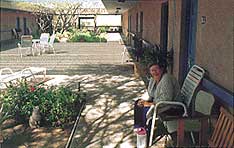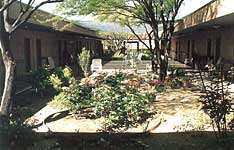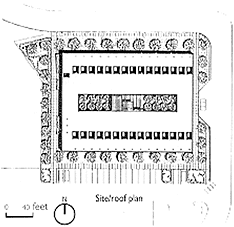 |
|
Project Summary: Viviendas Asistenciales
OWNER/DEVELOPER
Tucson Community Development/Design Center
ARCHITECT
Tucson Community Development/Design Center
Centro de Arquitectura y Urbanismo para la Comunidad
CONTRACTOR
George Codd and Co.
PROPERTY MANAGEMENT
Biltmore Properties
| FUNDERS: | TYPE: |
| HUD 202 | Loan |
| HUD Section 8 | Rent subsidy |
DEVELOPMENT TYPE:
New construction rental flats.
RESIDENT PROFILE:
Low-income seniors and persons with disabilities.
DENSITY: 25 units per acre
DEVELOPMENT PROFILE
| Type | #/Units | Size (sf) | Rents |
| 1 BR | 31 | 602 | $149, (HUD pays diff. FMR and 30% income) |
| Total | 31 | | |
Community/laundry: 552 (includes office & kitchen)
Courtyard: 6800
Parking: 20, surface
Total site area: 53,784 (1.24 acres)
|
CONSTRUCTION TYPE
Glue-laminated main beams on steel posts on drilled concrete piers;
woodframe rafters and nonbearing walls, stucco exterior finish.
DEVELOPMENT COSTS:
Land cost: $37,600; Constr. costs: $962,539; Other costs: $116,749;
Total development costs: $1,116,976; ($36,031/unit); Completed 1983.
|
|
|
VIVIENDAS ASISTENCIALES, Tucson, Arizona
 The Viviendas Asistenciales housing for the elderly and people with disabilities has 31 completely accessible units with individual courtyards grouped around a common courtyard. In its use of courtyards the design reflects desert architecture the world over. Desert trees and an operable dacron canopy shield the main courtyard from the hot sun to improve the comfort of the residents. The housing is located next to a county facility offering health and social services, across the street from a large private full-service shopping center, and one block from the city's main hospital. This location is a boon to residents who cannot afford or do not drive automobiles. The Viviendas Asistenciales housing for the elderly and people with disabilities has 31 completely accessible units with individual courtyards grouped around a common courtyard. In its use of courtyards the design reflects desert architecture the world over. Desert trees and an operable dacron canopy shield the main courtyard from the hot sun to improve the comfort of the residents. The housing is located next to a county facility offering health and social services, across the street from a large private full-service shopping center, and one block from the city's main hospital. This location is a boon to residents who cannot afford or do not drive automobiles.
 The Tucson Community Development/Design Center, which developed and owns Viviendas Asistenciales, paid $37,600 for the property -- instead of the $400,000 at which the land was valued -- because Pima County offered the land via a public process to any developer who would agree to provide 30 units of fully subsidized elderly and handicapped housing for 40 years, and who offered to return title of the property to Pima County at the end of that period. Although it is not strictly family housing, Viviendas illustrates two important points: 1) that economical and attractive design can be climatically appropriate, and 2) that elderly and disabled people can enjoy the opportunity to create a larger "family" within their housing complex. The Tucson Community Development/Design Center, which developed and owns Viviendas Asistenciales, paid $37,600 for the property -- instead of the $400,000 at which the land was valued -- because Pima County offered the land via a public process to any developer who would agree to provide 30 units of fully subsidized elderly and handicapped housing for 40 years, and who offered to return title of the property to Pima County at the end of that period. Although it is not strictly family housing, Viviendas illustrates two important points: 1) that economical and attractive design can be climatically appropriate, and 2) that elderly and disabled people can enjoy the opportunity to create a larger "family" within their housing complex.

|